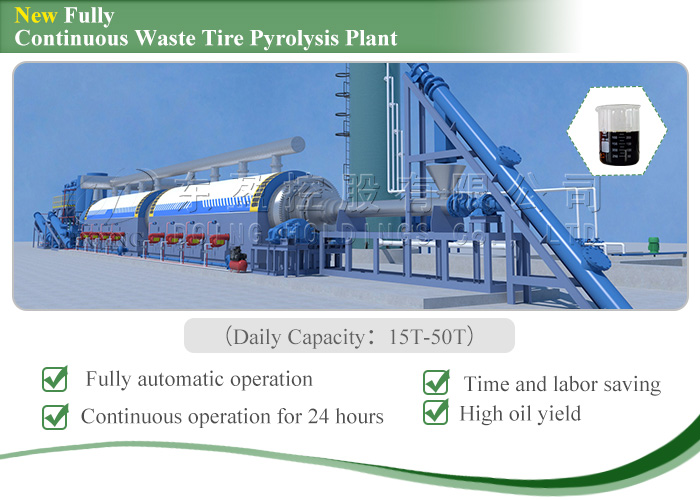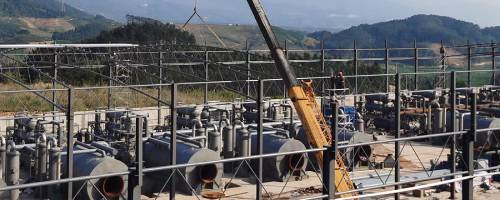Fully continuous waste tire pyrolysis plant
Nowadays, the recycling of "black pollution", i.e. waste tire pollution, and "white pollution", i.e. white plastic pollution, is a worldwide problem. People are starting to pay attention to this big problem, and the traditional refining can no longer keep pace with the development of society, so those who want to engage in this industry had better adopt the technologically advanced full continuous waste tire pyrolysis plant. Fully continuous waste tire pyrolysis plant can feed and discharge carbon black at the same time, working continuously for 24 hours without stopping. Compared with batch type waste tire pyrolysis plant, workers need to load and process waste tires, plastics and other raw materials in batches, and wait for the reactor to cool and discharge carbon before proceeding to the next batch.
 Fully continuous waste tire pyrolysis plant 3D image
Fully continuous waste tire pyrolysis plant 3D image
What's the working flow of fully continuous waste tire pyrolysis plant?
1. Pre-treatment of waste tires
Use steel wire pulling machine pulls out the steel wires from the waste tires. Then the waste tire shredder crushes the large tires into small pieces, which are fed into the pyrolysis reactor by the automatic screw feeder.
2. Heating the pyrolysis reactor
Heat the pyrolysis reactor with a bottom heating system, and when the temperature inside the reactor reaches a certain degree (about 200℃), oil gas is produced and then enters the oil gas condensing system.
3. Cooling the oil gas
Heavy particles in the oil gas will be liquefied into heavy oil through manifold in the first step of condensing system and stored directly in the heavy oil tank. The light particles in the oil gas will enter the horizontal condenser, the vertical condenser and condensing tower and then be liquefied into light oil, which is stored in the light oil tank.
4. Discharging carbon black
Waste tires is pyrolyzed into oil gas as well as carbon black, which will be discharged by carbon black screw hoist automatically.
5. Recycling combustible gas
Combustible gas is the oil gas which can’t be condensed. The gas will be purified and remove sulphur in the water seal device, and then used as fuel to heat the pyrolysis reactor.
6. Emission
The smoke emitted throughout the pyrolysis process will also be filtered by smoke cleaning system so as to meet the EU environmental emission standards.
What's the advantage of fully continuous waste tire pyrolysis plant?
1. Fully automatic with low labour cost
Doing fully continuous waste tire pyrolysis plant is controled by PLC system with automatic feeding and discharge system, which only need 1-2 worker for operating the PLC or computer is ok.
2. Fully pyrolysis for high oil output
Doing fully continuous waste tire pyrolysis plant adopts mutiple reactor design which can make fully pyrolysis of waste tires, thus to get high oil output.
3. Big capacity
Also due to continuous feeding and discharge system, and unique mutiple reactor design, Doing fully automatic continuous waste tyre pyrolysis plant can process at least 10 tons waste tires per day, up to 100T/D.
4. Internal rotating for conitnuous operation
For external rotating system, you have to change the sealing material every three days, thus cannot achieve the real sense of continuous process. But Doing continuous waste tyre pyrolysis reactor adopts internal rotating method, which no need to worry about the sealing of the external rotating system.
5. Long working life
During the continuous pyrolysis process, reactor heating is by indirect hot air heating, which will not damage reactor so much, thus to keep long usage life of the reactors. And since the hard steel wire already removed from waste tires before pyrolysis processs, thus no damage for the reactor.
Fully continuous waste tire pyrolysis plant technical data
| No. | Item | Specifications | ||||||
| 1 | Model | DY-C-10 | DY-C-20 | DY-C-30 | DY-C-50 | DY-C-60 | DY-C-80 | DY-C-100 |
| 2 | Cpacity | 10T/D | 20T/D | 30T/D | 50T/D | 60T/D | 80T/D | 100T/D |
| 3 | Power | 35Kw | 50Kw | 65Kw | 80Kw | 90Kw | 105Kw | 120Kw |
| 4 | Working type | Continuous | ||||||
| 5 | Reactor deisgn | Mutiple reactors (The quantity and size depends on the raw material condition) | ||||||
| 6 | Rotating | Internal rotating | ||||||
| 7 | Cooling system | Recycled waster cooling | ||||||
| 8 | Reactor material | Q245R/Q345R boiler plate | ||||||
| 9 | Heating method | Indireact hot air heating | ||||||
| 10 | Heating fuel | Fuel oil/gas | ||||||
| 11 | Feedstock | Waste tire/plastic/rubber | ||||||
| 12 | Output | Fuel oil, carbon black | ||||||
| NO | Name | Percentage(%) | Usage |
| 1 | Tyre oil | 40~45 | * can be sold directly. |
| * can be as fuel. | |||
| 2 | Carbon black | 30~35 | * can be sold directly. |
| * can be processed into pellets used for industrial heating or made into fine carbon by carbon black refining machine. | |||
| 3 | Steel wire | 12~15 | * can be sold directly. |
| 4 | Sync gas | 5 | * can be recycled as auxiliary heating fuel |
Request Information
Send your inquiry for further information





